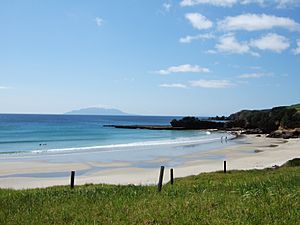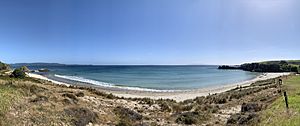Tāwharanui Peninsula facts for kids
Tāwharanui Peninsula is a finger of land projecting into the Hauraki Gulf from the east coast of the much larger North Auckland Peninsula of New Zealand. It separates Omaha Bay to the north from Kawau Bay and Kawau Island to the south. The nearest sizable town is Warkworth.
Tāwharanui Regional Park covers 588 hectares of the peninsula's land and Tāwharanui Marine Reserve covers the northern coastal sea. Both are administered by Auckland Council which also owns the regional park.
Geologically the peninsula consists of Waitemata Sandstone on top of folded and uplifted greywacke.
History
Māori lived in the area for over 800 years. The Māori name Tāwhara-nui refers to "the abundant bracts of the kiekie vine". Until the 1870s, the park was occupied by a small hapū (sub-tribe) of the Te Kawerau people called Ngati Raupo. The people lived mainly around the catchment of the Mangatawhiri Stream. A significant pā, Oponui, was near the entrance to the park and above the stream outlet was Pa-hi (meaning "lofty fortified settlement"). Tāwharanui provided a large variety of marine and forest resources. This was celebrated in the saying, "He wha tāwhara ki uta; he kiko tamure ki tai" – "The flowering bracts of the kiekie on the land, the flesh of the snapper in the sea". Waikokowai (Anchor Bay) provided a valued source of kokowai or red ochre, which was used for decorative and ceremonial purposes.
Tāwharanui was sold by the Māori owners in 1873–1877 and developed as a farm by the Martin, Jones and Young families. Kauri timber was milled and manuka cut for firewood for many years. Shingle was extracted for a hundred years, creating the Jones Bay Lagoon. Nine vessels were wrecked on the Tāwharanui coastline between 1871 and 1978. Anchor Bay is named after the anchor of the Phoenix, wrecked in 1879. The Auckland Regional Authority, forerunner of the Auckland Council, purchased the parkland from the Georgetti family in 1973.
Demographics
| Historical population | ||
|---|---|---|
| Year | Pop. | ±% p.a. |
| 2006 | 1,365 | — |
| 2013 | 1,620 | +2.48% |
| 2018 | 1,962 | +3.91% |
The Tawharanui Peninsula statistical area covers the area east of Warkworth, including Omaha and Port Wells. It had a population of 1,962 at the 2018 New Zealand census, an increase of 342 people (21.1%) since the 2013 census, and an increase of 597 people (43.7%) since the 2006 census. There were 783 households. There were 966 males and 996 females, giving a sex ratio of 0.97 males per female. The median age was 55 years, with 276 people (14.1%) aged under 15 years, 186 (9.5%) aged 15 to 29, 924 (47.1%) aged 30 to 64, and 579 (29.5%) aged 65 or older.
Ethnicities were 95.1% European/Pākehā, 6.6% Māori, 2.0% Pacific peoples, 1.5% Asian, and 1.4% other ethnicities (totals add to more than 100% since people could identify with multiple ethnicities).
The proportion of people born overseas was 19.1%, compared with 27.1% nationally.
Although some people objected to giving their religion, 57.6% had no religion, 33.8% were Christian, and 1.5% had other religions.
Of those at least 15 years old, 390 (23.1%) people had a bachelor or higher degree, and 195 (11.6%) people had no formal qualifications. The median income was $37,700. The employment status of those at least 15 was that 693 (41.1%) people were employed full-time, 318 (18.9%) were part-time, and 21 (1.2%) were unemployed.
Regional park
The park combines a "mainland island" sanctuary for the conservation of native plants and animals with farmland and public recreation areas. The park is mostly grazed pasture with manuka scattered throughout and patches of coastal forest. The most significant area of coastal forest is in the central eastern part of the park where kauri and rimu dominate the ridges, with puriri, taraire, tawa and, less often, rewarewa and nikau in the valleys. Elsewhere there are totara, kahikatea, pohutukawa, cabbage trees, karaka and New Zealand flax.
The mainland island was created by the construction of a 2.5 km pest-proof fence across the peninsula in 2004. This was followed by an aerial drop of poison later in 2004 which eliminated black rats, brown rats, feral cats, possums, weasels, stoats and ferrets. Introduced pests remaining in the sanctuary are mice, rabbits and hedgehogs. The Tawharanui Open Sanctuary Society Inc. (TOSSI) assists Auckland Council with the sanctuary by fundraising and volunteer work.
Sixteen species of native land birds and 15 species of native coastal birds have been recorded in the park. Wetland birds include the Australasian bittern, spotless crake and fernbird. Coastal birds include the New Zealand dotterel, blue reef heron and variable oystercatcher.
Marine Reserve
Tāwharanui Marine Reserve was established in September 2011. The marine reserve replaced the Tāwharanui Marine Park, which was established in 1981 as New Zealand's first Marine Protected Area. It covers approximately 400 hectares, from Mean High Water Mark out to half a nautical mile into the sea, along three kilometres of the coastline. Regulations prohibit the taking of any marine life. The diverse coastline contains a range of subtidal habitats, including reefs with overhangs, tunnels and caves. Schools of red moki, blue maomao, spotty, red mullet and koheru are common. North Island brown kiwi was reintroduced into the area. Cetaceans such as bottlenose dolphin and orca or other species also visit the waters nearby.
See also
 In Spanish: Península de Tawharanui para niños
In Spanish: Península de Tawharanui para niños



